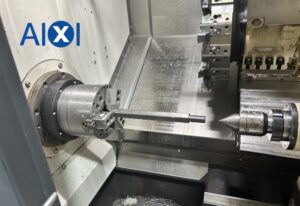Classification, characteristics, functions and usage precautions of cutting oil in machining
Mechanical cutting oil is a special lubricating oil. It is mainly used for lubrication, cooling, cleaning, anti-corrosion and other functions during metal cutting. It can improve cutting quality, extend the life of cutting tools, improve production efficiency and reduce costs. . Correct selection and use of mechanical cutting oil, and regular replacement and maintenance of cutting oil are one of the key measures to maintain the stability of the cutting process and improve cutting quality. In machining, like machining equipment and cutting tools, cutting oil (coolant) also plays a vital role.


Classification and characteristics of cutting oil
Cutting oil can be roughly divided into two categories: water-soluble cutting oil and insoluble cutting oil. Insoluble cutting oil can be used directly and focuses on lubrication (there are also a few that focus on cooling). Water-soluble cutting fluids are usually used after being diluted with water, focusing on cooling. Each cutting oil can be further subdivided. Since the characteristics of different types vary, the appropriate cutting oil must be selected according to the processing method and material.
water soluble cutting oil
Water-soluble cutting fluid is a cutting oil mixed with water and oil. It has a higher cooling capacity than non-water-soluble types and is easier to use because it is non-flammable, so it is widely used in high-speed machining in machining centers. It requires careful management as it can easily degrade over time. Commonly used water-soluble cutting fluids are divided into three types: emulsion, soluble and soluble liquid types according to their composition and appearance when used.
Emulsion: A water-soluble cutting fluid made from water, oil and surfactants. As the name suggests, when mixed with water, it emulsifies and turns into a milky liquid. The oil particles are larger and have excellent lubricity among water-soluble oils. Can be used for heavy cutting with high cutting resistance.
Soluble Fluid: Water-soluble cutting oil made from water, oil, surfactants and soluble substances. When mixed with water, it becomes translucent or transparent. It maintains a good balance of lubrication, cleaning power and cooling, with excellent cooling and penetration properties. Making it suitable for a wide range of applications including cutting and grinding.
Solution: A water-soluble cutting oil made from water and soluble substances that does not contain any oil. The oil particles are very small. It is initially transparent. When mixed with water, the liquid is usually green and has excellent cooling and durability. . It is characterized by defoaming and high cooling properties, making it suitable for grinding operations.
Insoluble cutting oil
Insoluble cutting fluid is a cutting oil with oil as the main component (also known as straight oil), which can be used without dilution. It has excellent lubricity, rust resistance and permeability, and is suitable for high-precision processing. However, due to its flammability, it is not suitable for unmanned operation.
Insoluble cutting oil is divided into two types: active and inactive according to its ingredients such as oil additives, extreme pressure additives, and rust inhibitors that enhance the strength of the oil film on the friction surface.
The active type always contains extreme pressure additives, which are ideal for difficult-to-cut materials and gear machining, and can effectively improve machining accuracy. There are two types of inactive types: those with extreme pressure additives and those without extreme pressure additives. They are further divided into three types according to their corrosion characteristics against copper. They are mainly suitable for light cutting and softer workpieces, and can effectively increase tool life.
The role of cutting oil in machining
1.lubricating:
Cutting fluid can form an oil film on the surface of workpieces and tools, and can also penetrate into the smallest metal gaps and irregularities, reducing friction between metals. This can bring about the following effects:
① Reduce tool wear and extend tool life.
② Reduce cutting resistance and enable processing with less power.
③ Prevent burrs from appearing on the edges and improve the accuracy of the processed surface.
2.Cooling:
Cutting fluid can reduce the heat generated during cutting operations, and its temperature can be as high as 600-1000°C. Especially for workpieces with low thermal conductivity like stainless steel, it is difficult to dissipate heat and the workpiece will become hot. Using cutting fluid to reduce temperature can bring the following effects:
① Reduces the thermal deformation of the tool and extends the tool life.
② Stabilizes machining accuracy by preventing thermal deformation of the workpiece and tool.
③ High-speed processing is achieved.
3.Cleaning:
Spraying cutting fluid can wash away the chips generated during the cutting process and clean the workpiece, which can bring the following effects:
① Prevent chips from adhering and causing scratches on the workpiece.
② Prevent processing defects caused by chip clogging and accumulation.
③ Prevent tool damage caused by entangled chips.
4.Anti-rust:
After cutting, the metal surface is exposed without any protective film, making it highly susceptible to oxidation, deterioration, and discoloration. Moreover, machines and tools, especially those with higher rigidity, are prone to rust. Cutting oils often have strong anti-rust properties, helping to protect machines, tools and products. Generally speaking, non-water-soluble cutting oil has a higher anti-rust effect.
How to use machining cutting oil
There are two main ways to use cutting oil: external lubrication and internal lubrication. Each method has its own advantages and disadvantages, so it is important to choose the appropriate method based on your processing needs and type.
- External lubrication method
The external lubrication method involves the use of an external device called a coolant hose to supply cutting oil to the machining area. This method may involve manually adjusting the position of the nozzle or using numerical control (NC) to adjust the angle.
- Internal lubrication method
The internal lubrication method supplies cutting oil through a port located on the machine tool spindle or tool. This method allows for higher pressure and more precise application of cutting oil than external lubrication. It is particularly effective for machining processes involving deep holes or grooves that are difficult for cutting oil to reach.


Things to note when choosing cutting oil for machining
When choosing cutting oil, you should choose the most effective method according to your own needs. When choosing, you should pay attention to the following points:
1.Select according to processing technology
Choose cutting oil according to the machining process. Lathe operations requiring high-speed machining benefit from water-soluble cutting oils with good cooling properties. The milling process requires the lubricating properties of non-water-soluble cutting oils to prevent chipping. Drilling processes focus on cooling, often using water-soluble emulsions. The grinding process requires the cutting oil to have both lubricating properties to reduce frictional heat and cooling properties to eliminate the heat generated. Soluble oils are ideal for grinding processes.
2.Select according to workpiece material
For steel cutting where lubrication is important, emulsion-type water-soluble cutting oils are suitable, while active forms of non-water-soluble cutting oils are preferred. For cast iron, anti-rust properties are crucial, so non-water-soluble cutting oils are suitable. Aluminum alloys require cutting oil to prevent discoloration. Copper alloys require non-water-soluble options, but active forms should be avoided due to copper corrosion.
Precautions when using cutting oil
When using cutting oil, it is important to prevent its effects on the body and the environmental impact of oil degradation. Here are some things to note:
- Precautions for self-protection during use
Cutting oil on the skin can cause irritation and rash. It is important to wear protective clothing that minimizes skin exposure and wear gloves to prevent oil contact. Contact with cutting oil may cause eye irritation and may be potentially hazardous due to debris contained in the dispersed oil mist. Inhaling the odor of cutting oil and oil mist can cause symptoms such as discomfort and headaches. Therefore, it is essential to wear protective glasses and a mask to protect your eyes and nose when working with cutting oils.
- Effect of oil mist diffusion
Working with cutting oil can cause oil mist (“mist”) to spread during work, causing walls and floors to become slippery. Oil mist components can also affect human health, so measures to reduce the spread of oil mist, such as reconsidering the type and amount of cutting oil used or installing piping, are crucial.
- Regular maintenance
Routine management and inspections are critical to maintaining cutting oil performance. Water-soluble cutting oils, in particular, can produce an unpleasant odor when the machine is idle for a long time, and can cause rapid growth of bacteria, affecting health.

 Deutsch
Deutsch Français
Français 日本語
日本語 Español
Español

